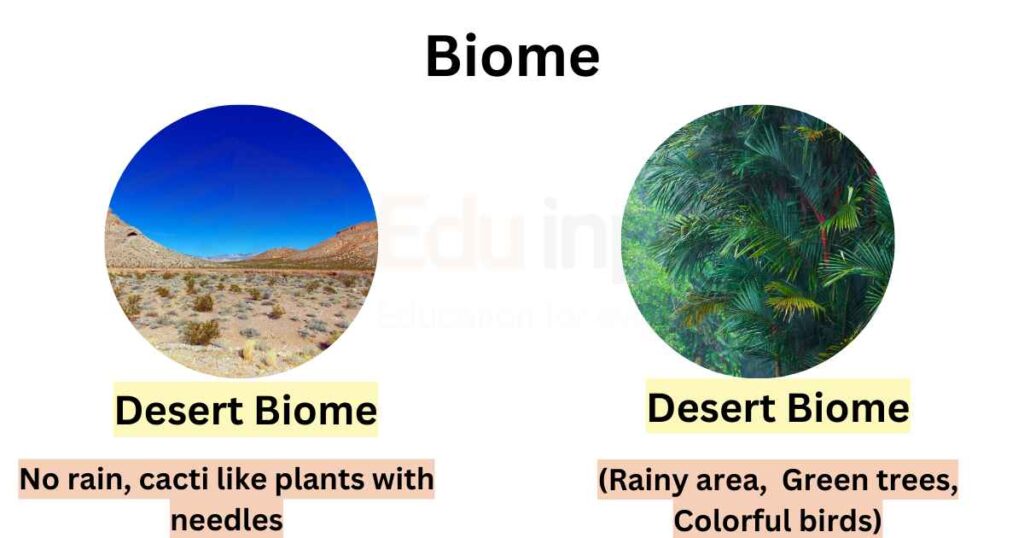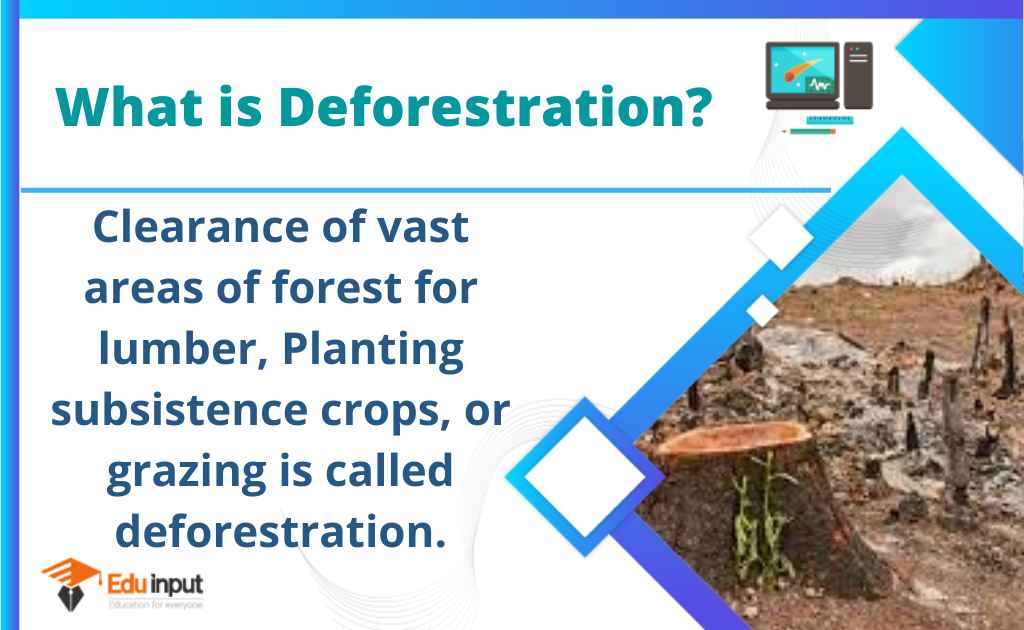What is Biome? (Definition, Types, Examples and Importance)
Biome Definition
Biome is a large geographical region characterized by a specific set of environmental conditions, such as climate, soil type, topography, and vegetation.
Biomes are categorized based on their climate, which is the primary factor that determines the types of organisms that can thrive in the region.
Also learn: What factors primarily determine a biome?

| Key Points |
|---|
| 1. A biome is a large geographical region with specific environmental conditions like climate, soil type, topography, and vegetation that categorize based on their climate. 2. Each biome has its unique climate, which determines the types of organisms that can survive there. 3. Examples of biomes include tropical rainforests, deserts, tundra, grasslands, taiga, temperate deciduous forests, savannas, wetlands, coral reefs, estuaries, and polar ice caps. 4. There are different types of biomes such as tundra, taiga, desert, freshwater, tropical rainforest, grassland, and savanna, each with unique features and characteristics. 5. Pakistan has several biomes, including the Himalayan mountain range, the Indus River Delta, and the Thar Desert, which include the desert, mountain, and coastal biomes. 6. Biomes refer to large, geographically distinct regions with similar environmental conditions, while ecosystems are smaller, self-contained communities of organisms that interact with each other and their environment. |
How to Understand Biome?
Imagine that you are going on a trip around the world. As you travel to different places, you notice that the plants and animals around you start to look very different. For example, when you visit a tropical rainforest, you see tall trees with lots of leaves and vines hanging down. You also see colorful birds and monkeys swinging through the trees.

Then, you travel to a desert, and everything looks very different. Instead of tall trees, you see cacti with long needles and lizards sunbathing on rocks.
These different places you’re visiting are called biomes. A biome is like a big community of plants and animals that all live together in a specific type of environment.
Each biome has its own unique climate, which is the type of weather and temperature that it has. This climate helps determine what kinds of plants and animals can survive there. For example, in a tropical rainforest, it’s always hot and rainy, so plants like orchids and animals like toucans can live there.
In a desert, it’s very dry and hot, so plants like cacti that can store water and animals like camels that can go a long time without drinking can survive.
So, when you visit different biomes, you get to see all kinds of different plants and animals that have adapted to live in those environments. Each biome is like a little world of its own.
Analogy for Biome
Imagine Earth as a giant apartment building. Each biome is a unique floor, with its own characteristic temperature and lighting. The desert floor might be hot and sunny, while the rainforest floor is lush and humid. Each floor houses specific tenants – plants and animals adapted to thrive in those conditions. Just like people wouldn’t put a cactus in their living room, a polar bear wouldn’t survive in the desert!
Examples of Biome
Here is a list of 14 biomes of the world:
- Tropical rainforest
- Desert
- Tundra
- Grasslands
- Temperate deciduous forest
- Taiga
- Temperate rainforest
- Savanna
- Chaparral
- Alpine
- Wetlands
- Coral reefs
- Estuaries
- Polar ice caps
Types of Biomes
There are several types of biomes, each with unique features and characteristics. Some of the most common biomes include tundra, taiga, desert, freshwater, tropical rainforest, grassland, and savanna.
Tundra Biome
The tundra biome is a cold, treeless region found in the northernmost regions of the Earth. It is characterized by low temperatures, short growing seasons, and permafrost. Permafrost refers to a layer of frozen soil that prevents plants from rooting deeply.
The vegetation in the tundra biome includes low-lying shrubs, mosses, and lichens, as well as hardy grasses and sedges.
Taiga Biome
The taiga biome, also known as the boreal forest, is found in the northern hemisphere. It is characterized by coniferous trees, such as spruce, fir, and pine.
The taiga biome has long, cold winters and short, mild summers, and supports a diverse range of wildlife, including moose, wolves, and bears.
Desert Biome
The desert biome is a region characterized by extremely dry conditions, with very little rainfall. Deserts can be found in several regions around the world, including the Sahara in Africa and the Mojave in North America.
The vegetation in the desert biome is typically sparse and adapted to the harsh, arid conditions.
Freshwater Biome
The freshwater biome includes rivers, lakes, and wetlands. These ecosystems are characterized by flowing or standing water, and support a diverse range of aquatic life, including fish, amphibians, and invertebrates.
Tropical Rainforest Biome
The tropical rainforest biome is a hot, humid region found near the equator. It is characterized by dense vegetation, including tall trees, vines, and epiphytes.
The rainforest biome is home to a wide variety of plant and animal species, many of which are found nowhere else on Earth.
Grassland Biome
The grassland biome, also known as prairie or steppe, is characterized by vast stretches of grasses and wildflowers. Grasslands are found in several regions around the world, including North America, Africa, and Asia.
Grasslands support a diverse range of grazing animals, including bison, antelope, and zebras.
Savanna Biome
The savanna biome is a region characterized by tall grasses and scattered trees. Savannas are found in several regions around the world, including Africa, South America, and Australia. The savanna biome is home to a diverse range of wildlife, including elephants, lions, and giraffes.
Difference Between Biome and Ecosystem
The terms “biome” and “ecosystem” are often used interchangeably, they actually refer to different levels of ecological organization. A biome is a large geographical area that is characterized by a specific set of climatic conditions and the living organisms that inhabit that area. An ecosystem is referred as the interactions between living and nonliving components within a specific area.
Biomes refer to large, geographically distinct regions with similar environmental conditions, While ecosystems are smaller, self-contained communities of organisms that interact with each other and their environment. Ecosystems can exist within biomes, but are not limited to them.
Also Read:
FAQs
why is a tropical rainforest a biome?
A tropical rainforest is considered a biome because it is a large geographical region with a distinct set of plant and animal species that have adapted to living in the unique environmental conditions of that region.
Which biome has the most biodiversity and why?
A: The tropical rainforest biome is considered to have the most biodiversity of any biome on Earth. The high temperatures and abundant rainfall create a lush and dense canopy of trees, which provides a habitat for a diverse range of species. Additionally, the tropical rainforest biome has a wide variety of microhabitats, including the forest floor, understory, and canopy, which provide different environments for species to thrive.
How biome differ from biosphere?
A biome is a large geographical region with a specific climate, vegetation, and animal life. In contrast, the biosphere refers to the global sum of all ecosystems, including all living organisms and the physical environment in which they live. While a biome is a specific type of ecosystem, the biosphere encompasses all of the world’s ecosystems, from the tiniest microorganisms to the largest biomes.

 written by
written by 




Leave a Reply